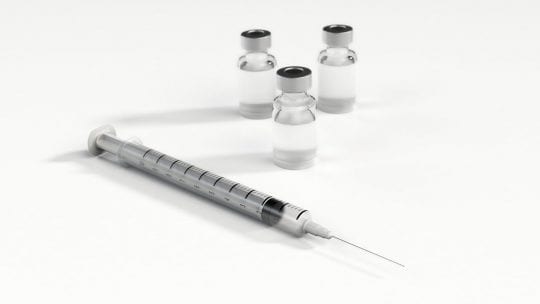
Communicators are facing a critical situation to get the vaccine narrative right. The FDA and CDC released a statement today (April 13) recommending a temporary pause in the administration of Johnson & Johnson's COVID-19 vaccine. This follows reports of six cases of a "rare and severe" blood clot among more than 6.8 million doses of Johnson & Johnson vaccine in the United States.
Johnson & Johnson (J&J) also released a statement. In it, the company used phrases such as “extremely rare” and “open communication” not to minimize anything, but to demonstrate it is working with proper channels to find answers.
Carrie Jones, principal at JPA Health, said it’s important to establish a considerate context.
“At this point, the public needs to receive clear, consistent and timely information,” Jones said. “They need to understand that the purpose of pausing Johnson & Johnson’s vaccine administration is to enable healthcare professionals...time...to provide appropriate treatment to patients, should they experience blood clots."
Jones added, "It’s also important to put this into scientific and medical context. As of April 12, only six cases have been reported out of more than 6.8 million doses—the relative risk of dying from COVID-19 is greater than the risk of a blood clot side effect.”
However, Jones noted that health PR faces an uphill battle. It must recover public trust after a year of perplexing messaging.
Communicators, she said, "must consider the broad spectrum of audiences within the general public—each with unique experiences, diverse cultures and their own personal health journey. That, along with navigating months of confusion and mixed messages, makes engaging with the public especially hard.”
Proactive Outreach
The FDA and CDC conducted a live audio conference on YouTube this morning, addressing questions and their statement. They explained, with numerical data, why they recommend a pause. In addition, they announced a meeting of the Advisory Committee on Immunization Practices (ACIP) tomorrow (April 14) to review the cases further and assess their significance.
Healthcare communicators find themselves with a great responsibility to provide accurate information about vaccine safety, particularly to those who have taken the J&J vaccine. The information exists, but the public needs to know where to find it and what to do. This will help mitigate anxiety in an already-distrusting population.
Kwame Patterson, director of PR, EmblemHealth, knows patients—who have and were scheduled to receive the vaccination—will have questions, and that it’s important to strategize messaging surrounding their concerns.
“As the situation evolves, communications and PR professionals—especially those who work directly with patient populations—should conduct outreach to those who have already received the J&J vaccine, with clear and actionable information,” Patterson said. He used these examples:
- What we know: e.g., NY State noted in a statement that the CDC says the condition “appears to be extremely rare.”
- What to do: contact your health care provider if you have concerns or are experiencing symptoms
Patterson noted the importance of following up with those who were scheduled.
“For patients who were scheduled to receive the J&J vaccine, their primary concern will be: 'Does this mean I can’t get the vaccine? What’s next?'” Patterson said. “Targeted outreach, even if it's to say, 'We have canceled your appointment and will be following up ASAP' will be critical to keep vulnerable and vaccine hesitant populations engaged.”
The J&J pause will raise questions not only for those receiving that vaccine, but for vaccine safety overall, particularly with vaccine-hesitant populations.
“Communicators should stay the course by continuing to highlight vaccine success stories, proper language use, and data demonstrating safety and effectiveness,” he said.
Prime Time for Media
The New York Times broke the J&J news today, which may have raised concerns for many. However, it also shared a story titled: “J&J Vaccine and Blood Clots: A Risk, if It Exists, Is Tiny.”
The media has a big opportunity to influence the national conversation. As Gil Bashe, managing partner, global health, Finn Partners, says, “Headlines shape opinion.” Communicators also have a responsibility to get journalists correct information so they can tell an accurate story.
“For the past year, we have faced two pandemics: COVID-19 and the pandemic of poor communication,” Bashe said. “The public’s confidence in elected officials and scientists has been shaken as conflicting communications clearly made it more difficult to fight the virus. This CDC/FDA announcement is a double-edged sword—confidence or chaos.”
Bashe said the media plays an adjunct public health role in this situation. He urged media to get the language right and read—and re-read—the CDC/FDA statement and draw from its language.
“Media need to be mindful that anxiety impacts public health outcomes,” Bashe said. “This is not a time to invent drama or spark suspense. Public health requires officials and media work collaboratively to inspire thoughtful, balanced consumer action. The operative words in the statement are 'cautious pause.' Let’s hope that government and regulatory voices reinforce that this brief pause is geared to reassure people that science and safety always drive decisions.”
If anything, Bashe says, the J&J situation gives the media an opportunity to regain trust.
“From a public health standpoint, it’s the right moment to hit the reset button to secure confidence in science and public information. CDC and FDA need to reinforce—again and again—why they are reviewing these data and their possible 'significance'–if at all.”
Nicole Schuman is senior editor for PRNEWS. Follow her @buffalogal
